As George Orwell once didn’t quite observe:
At the dawn of the great meme wars of the post-Covid era, people didn’t quite appreciate the degree to which great fortunes could be won and lost with a single tweet. Nor was it clear who was fighting whom, or why. It took time for civilisation to understand the scope and parameters of the new Great Game. What was at stake. What the rules of engagement really were. How lives would be extinguished and lost.
In time, the nation-scale implications of finely crafted attacks from blue checkmark accounts became increasingly apparent. As they did, so did the collateral damage.
Most scholars now agree a critical flash point came on January 17, the day El Hodlador, one of the earliest sovereign adopters of a universal Declaration of Independence from the forces of centralisation, was inadvertently provoked via a false report about Moody’s downgrade of El Salvador’s credit rating.
What most trolling strategists never saw coming was how the provocation would escalate into a high stakes DGAF defensive manoeuvre. In the days to come, thousands of decentralised laser-eyed forces were rallied by El Hodlardor’s meme-powered president Nayib Bukele to inflict a campaign of irreparable shock and awe on the centralised node network.
But the fight was not over. Once regrouped and replenished, and as largely expected by the allied resistance, centralised nodes released their own rebuke. It came in the shape of the weaponisation of the IMF’s latest staff report of January 28, featuring no less than 114 references to El Hodlador’s adoption of bitcoin.
Critical observations included:
And that:
And finally a footnote that noted:
All hope for the forces of decentralisation soon hung in the balance. For now the meme wars continue . . .











